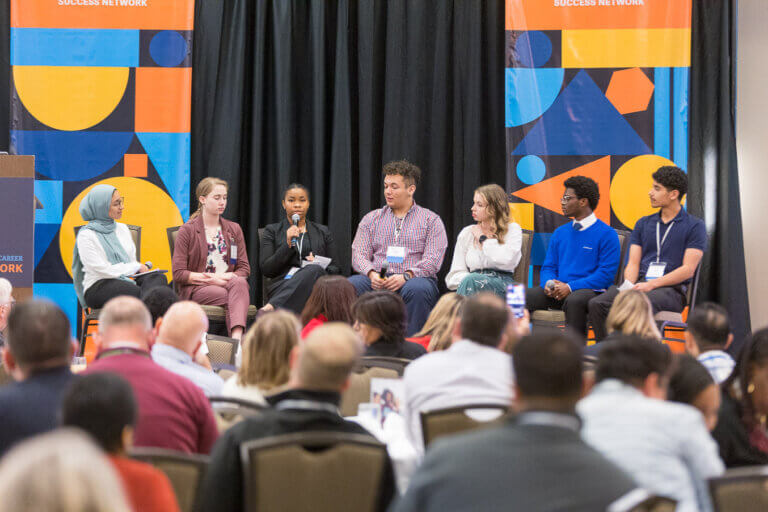As educators championing hands-on learning, we’re focused on guiding students from textbook knowledge to real-world application. Among the many career exploration experiences students can participate in, job shadows stand out as an opportunity for students to engage directly with industry professionals and experience a real-world workplace, bridging the gap between their classroom studies and future professional endeavors.
However, organizing impactful job shadowing experiences comes with its share of challenges, from juggling logistics to ensuring teacher support and student engagement. The best way to tackle this journey and provide a high-quality job shadow experience for both students and employer partners? Gather a group of people who are all grappling with the same questions.
Exploring Solutions Through Stakeholder Collaboration
At the Illinois Education and Career Success Network’s 2024 conference, a group of work-based learning stakeholders gathered for a roundtable discussion to address the following challenges related to student recruitment for job shadows, including:
- Teacher buy-in
- Student apathy
- Intentional preparation of students prior to a job shadow
- Tying job shadows to specific classes doesn’t guarantee the students are actually interested in the industry; for example, a manufacturing pathway student taking a health sciences course as an elective
- Different schools/instructors are using different criteria to determine if a student is eligible for a job shadow (GPA, on track to graduate, etc.)
The round table’s focus was on sharing insights and solutions to address the challenges, improve the effectiveness of job shadows, and ensure a high-quality and accessible experience for students. While at times during our discussion, we had more questions than answers, the challenges that schools posed for optimizing their job shadow experiences are all important questions for us to grapple with.
Addressing Teacher Concerns
A few schools shared that when surveying teachers, they expressed an interest in student participation in job shadows but didn’t want students to miss class. For AP and dual credit courses specifically, students can only miss a certain amount of days so there isn’t always teacher buy-in for these students to miss class to attend a job shadow. One way that schools are working to address this is by embedding job shadows as a required component of relevant courses. This will support teachers to better plan around and see the intrinsic educational value of job shadowing while ensuring student participation and engagement.
Additionally, some schools are exploring alternative scheduling options or offering job shadows on designated school days with minimal impact on class attendance. This year, Moline High School is piloting having job shadows for juniors and seniors occurring on state testing days; attending a job shadow would excuse a student from online learning. Some schools have explored offering a job shadow on a teacher institute day but run into challenges with transportation, as school buses aren’t available on those days.
Fluctuating Student Attendance Numbers
Many schools shared a concerning but common experience: the number of actual students who show up to a job shadow is significantly lower than the number the school expected and communicated to the employer partner. The fear of missing out) is natural for students, and schools have consistently heard from students that their choice not to participate resulted from worry about missing out on happenings at school with their friends. While this is an ongoing discussion, the group did share the following thoughts on how to address this:
- Leverage the experiences of students who have participated in job shadows to promote future opportunities and encourage their peers to get involved to help them understand the value of participating.
- Implementing strategies to mitigate student apathy, such as setting clear expectations, deadlines, and consequences for not participating. Some schools are considering incorporating incentives or rewards for students who actively engage in job shadow opportunities.
- Consider alternative meal arrangements such as students bringing their own sack lunch or having job shadows scheduled outside of lunch hours to accommodate fluctuating attendance numbers and avoid having an employer partner provide lunch for the higher number expected to attend.
- Have a list of student alternates ready in case there are students who decide at the last minute not to join.
Field Trip Forms as a Barrier to Participating
Since job shadows are off-site at an employer site, many schools shared that one of their biggest challenges is getting students to turn in their field trip forms on time to attend the job shadow. Rockford Public Schools shared how they utilize universal permission forms that cover all work-based learning events throughout the school year to streamline the administrative process and ensure students are prepared for potential opportunities.
Standardizing Eligibility Criteria
Schools are interested in further reviewing and revising the criteria counselors use to recommend or excuse students from attending job shadows to ensure equitable access and opportunities for all students. The criteria typically used to deny a student a job shadow are attendance and behavior concerns, but these can be the students who may benefit most from this experience.
While the schools vary in the criteria they use, they are interested in district-wide or regional standards that all students must meet to participate in job shadows. These could include factors such as GPA, attendance, completion of prerequisite coursework, or teacher recommendations. Even with standardized criteria, schools will need to take a holistic view of students so that a single criterion isn’t holding them back from an opportunity that could shift the way they think of themselves and what they want to explore further as a part of their pathway
Intentional Preparation of Students
While many schools shared that they utilize career interest surveys, they recognize that the resources and time for reflection that students are provided to complete the surveys are not always as intentional and informed as they would like it to be. Schools vary in the type of information and exposure to various career areas that are provided before students complete the survey. Students may also be completing their career interest surveys only once and early on in their high school experience, so this information may not reflect how their career interests are pivoting. They also noted concern that the schools are not using their data systems effectively to recruit for job shadows.
District 211 shared how using a career interest profiler, which has students create personal lists of careers they are interested in learning more about, has helped them reach more targeted groups of students–and more students overall–for work-based learning opportunities.
Prioritizing Student Voice Moving Forward
Gathering more student voices on how they want to be supported and what would interest them in a job shadow experience is an area of need that the schools expressed an interest in exploring. To that extent, the group seeks to engage students to answer the following questions:
- What would make an engaging job shadow opportunity you wouldn’t want to miss?
- Should there be incentives for attending and/or consequences for canceling at the last minute? If so, what should that look like?
Involving students in these questions positions them as stakeholders in their educational experiences and cultivates a sense of ownership and responsibility toward their professional development journey. Their insights and recommendations should be a key priority for how communities adjust and refine their job shadow experiences.
The Conversation Continues
Through collaborative efforts and innovative solutions, we can foster a culture of active participation and commitment in work-based learning initiatives, ultimately preparing students for success in their future careers.


